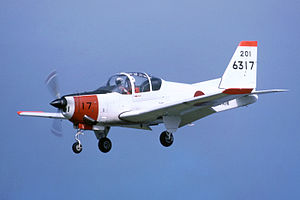Fuji T-5
| T-5 | |
|---|---|
 | |
| General information | |
| Type | Basic trainer |
| Manufacturer | Fuji Heavy Industries |
| Primary user | Japan Maritime Self-Defense Force |
| History | |
| Introduction date | 1988 |
| First flight | 28 June 1984 |
| Developed from | Fuji KM-2 |
The Fuji T-5 or KM-2Kai is a Japanese turboprop-driven primary trainer aircraft, which is a development of the earlier Fuji KM-2. The student and the instructor sit side-by-side.
Design and development
The Fuji T-5 was developed by Fuji Heavy Industries as a replacement for the piston-engined Fuji KM-2 (itself a development of the Beechcraft T-34 Mentor) as a primary trainer for the Japan Maritime Self-Defense Force. Fuji refitted a KM-2 with an Allison Model 250 turboprop engine in place of the original Lycoming piston engine, the resulting KM-2D first flying on 28 June 1984 [1] and being certified on 14 February 1985.[1][2] The KM-2Kai is a further development of the KM-2D, with a modernised cockpit with side-by-side seating and a sliding canopy replacing the original KM-2's car type side doors [2] (which were retained by the KM-2D[1]).
The T-5 is an all-metal low-wing cantilever monoplane powered by an Allison 250-B17D turboprop with a three-bladed constant speed propeller. It has a retractable tricycle landing gear with the main gear retracting inwards and nose gear rearwards. The T-5 has an enclosed cabin with a sliding canopy and two side-by-side seats, and dual controls, in the aerobatic version and four seats in pairs in the utility version.
Operational history
The KM-2Kai was ordered by the JMSDF as the T-5 in March 1987,[2] with deliveries of the KM2-Kai to the Japanese Self Defence Forces beginning in 1988, with a total of 40 being built. The T-5 serves with the 201 Air Training Squadron at Ozuki Air Field.[3] The original KM-2 is no longer in service.
Operators
Specifications (T-5)
Data from Jane's Aircraft Recognition Guide [4]
General characteristics
- Crew: 2
- Length: 8.4 m (27 ft 7 in)
- Wingspan: 10 m (32 ft 10 in)
- Height: 2.9 m (9 ft 6 in)
- Wing area: 16.5 m2 (178 sq ft)
- Airfoil: root: NACA 23016.5; tip: NACA 23012[5]
- Empty weight: 1,082 kg (2,385 lb)
- Max takeoff weight: 1,805 kg (3,979 lb)
- Powerplant: 1 × Allison Model 250-B17D turboprop, 261 kW (350 hp)
- Propellers: 3-bladed constant-speed propeller
Performance
- Maximum speed: 357 km/h (222 mph, 193 kn) at 2,440 m (8,005 ft)
- Cruise speed: 287 km/h (178 mph, 155 kn)
- Stall speed: 104 km/h (65 mph, 56 kn) [6]
- Never exceed speed: 413 km/h (257 mph, 223 kn)
- Range: 945 km (587 mi, 510 nmi)
- Service ceiling: 7,620 m (25,000 ft)
- Rate of climb: 8.6 m/s (1,690 ft/min)
See also
Related development
References
- ^ a b c Taylor, JWR, ed. (1988). Jane's All the World's Aircraft, 1988-1989. Coulsden, UK: Jane's Information Group. ISBN 0-7106-0867-5.
- ^ a b c Donald, David; Lake, Jon, eds. (1996). Encyclopedia of World Military Aircraft. London: Aerospace Publishing. ISBN 1-874023-95-6.
- ^ "Scramble". Archived from the original on 2007-04-03. Retrieved 2007-04-26.
- ^ Rendall, David (1995). Jane's Aircraft Recognition Guide. Glasgow, UK: HarperCollinsPublishers. pp. 505. ISBN 0-00-4709802.
- ^ Lednicer, David. "The Incomplete Guide to Airfoil Usage". m-selig.ae.illinois.edu. Retrieved 16 April 2019.
- ^ Taylor, M J H, ed. (1999). Brassey's World Aircraft & Systems Directory 1999/2000 Edition. London: Brassey's. ISBN 1-85753-245-7.
